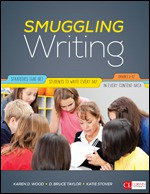Smuggling Writing
Strategies That Get Students to Write Every Day, in Every Content Area, Grades 3-12
- Karen D. Wood - University of North Carolina, Charlotte, USA
- D. Bruce Taylor - University of North Carolina, Charlotte, USA
- Katie Kelly - Furman University, USA
Corwin Literacy
Is it possible to sneak more writing into your already-jammed curriculum? Yes! With this cache of classroom-tested ideas, you have all you need to make writing-to-learn a daily habit for students that deepens their content understanding and creates learners ready to take on all of the world’s information.
Smuggling Writing shows how to integrate writing seamlessly into your lesson plans with 32 written response activities that help students process information and ideas in short, powerful sessions. The authors invigorate time-tested tools like GIST, Herringbone, and Anticipation Guides, and organize them into sections on Vocabulary and Concept Development, Comprehension, Discussion, and Research & Inquiry so you can select and use them to maximum effect.
Here are the success-ensuring how-to’s that accompany each strategy:
- A step-by-step process ensures students use the strategy before, during, and after reading/learning so they “own” the strategy and can track their thinking
- Engaging digital applications, including Story Impression with Bubbl.us, Reading Road Map with Prezi, Possible Solutions with Padlet, CLVG with Brain Pop
- Sample lessons showing both traditional and online formats, taking the guess work out of trying these new digital tools
- Ideas for “smuggling” additional writing opportunities into or after the lessons, ensuring that students’ writing skills improve
- Connections to Common Core State Standards
With all the heady talk of what it’s going to take for students to read, write, and analyze across multiple sources, it’s nice to know that there is a book that shows how big gains will come from “writing small” day by day.
Free resources

Collaborative Listening Viewing Guide
In this lesson from Smuggling Writing students learn to gather information from video and audio through structured note taking and collaborative discussion.
“Smuggling Writing shows teachers how to incorporate written response activity results into lesson plans that empower students in grades 3-12 to take charge of their own reading and writing growth. The idea is that more writing can be added to even the heaviest curriculum approach, and this is supported through classroom-tested lesson plans that show students how to use a particular set of strategies in all of their educational pursuits.”

